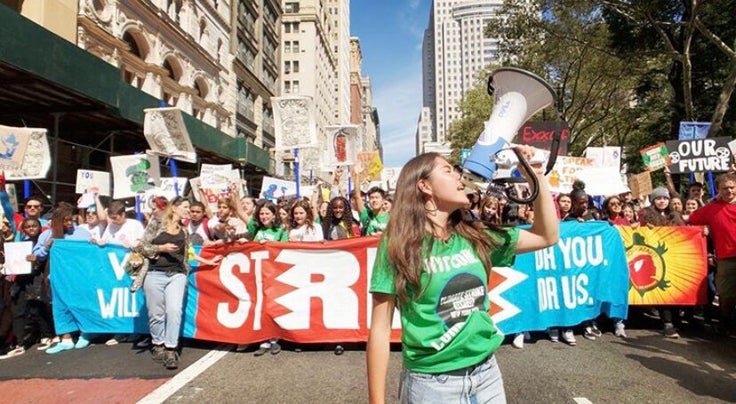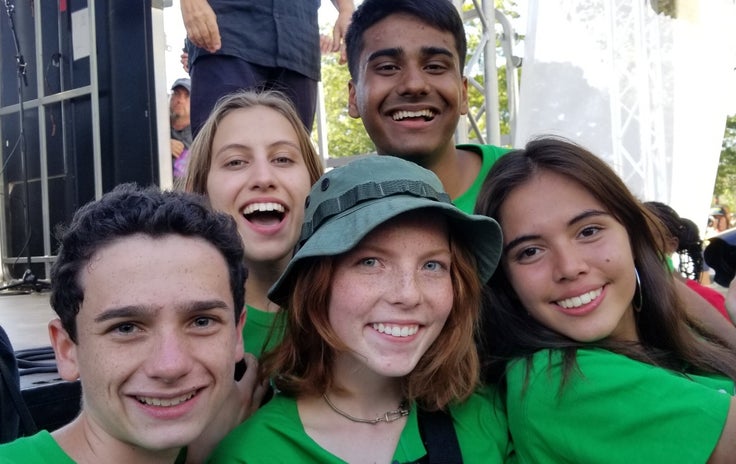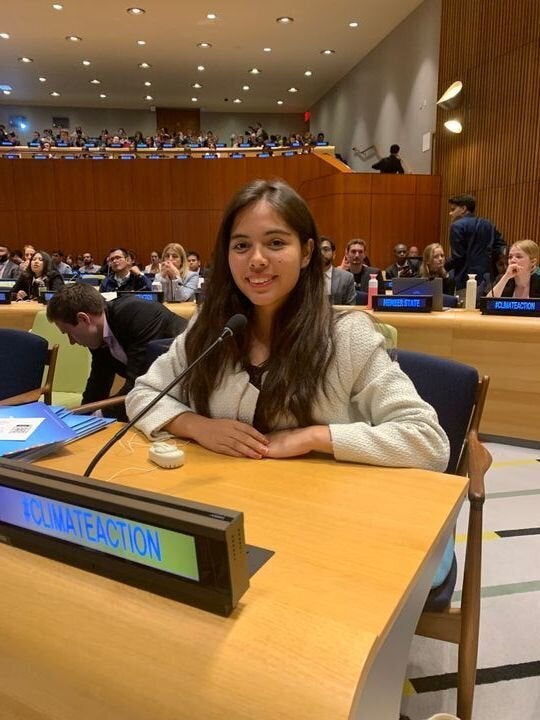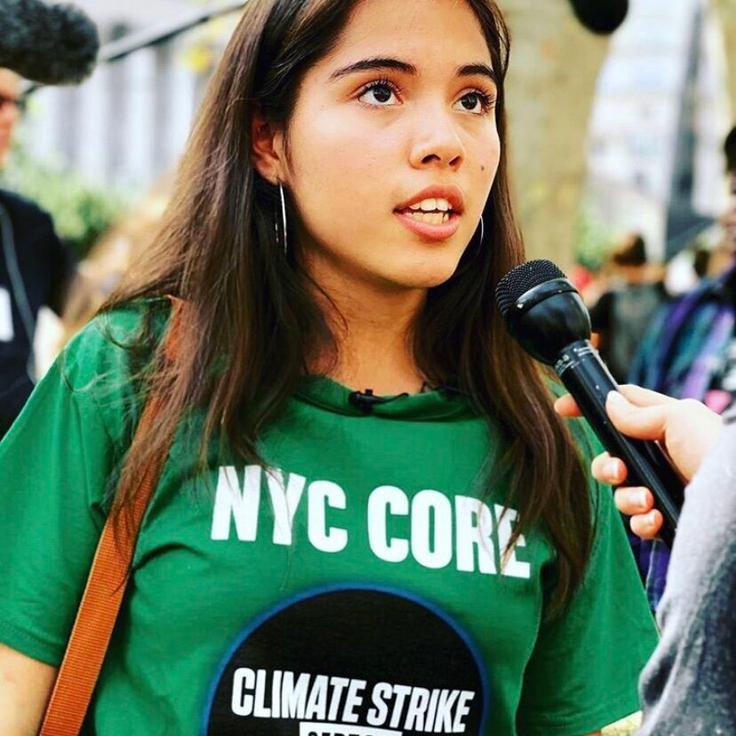Xiye Bastida, 17, grew up around drought and then heavy rainfall and flooding in her hometown of San Pedro Tultepec, a town outside of Mexico City. When she and her family moved to New York City four years ago, she learned about the devastation caused by Hurricane Sandy.
The effects of climate change were inescapable, Bastida learned. And she’s since set out to do as much as she can to stop the damage.
Bastida had always been aware of the need to protect the environment. Her mother and father met in Ecuador in 1992 at a climate change conference. And Bastida is part of the indigenous Otomí tribe, which nurtures reciprocity with the land.
When Bastida got to New York, she started an environmental club at her school. She joined several climate-focused groups, including the Peoples Climate Movement, the Sunrise Movement and Extinction Rebellion, and invited their leaders to speak at her school. She began lobbying lawmakers at the New York state capital in Albany.
Bastida was further inspired by fellow young activist Greta Thunberg, who first delivered a TED talk and spoke at the United Nations COP24 in 2018. Bastida became involved in the Fridays for Future strikes in New York, in which students skip school to demand action from government officials. Since then, she’s spoken at the United Nations herself and helped organize the first of two Global Climate Strikes this month. In fact, Bastida, who lives in Morningside Heights, was one of the youth organizers who lobbied City Council members to request excused absences for students who joined the demonstration that took place Sept. 20.
We spoke with Bastida ahead of the global climate strike about finding her voice, how her activism has impacted her life as a high school student and the challenges in making sure diverse voices like hers remain at the forefront of this work.

How did you realize your story was a climate change story?
When I was 13 in 2015, my town suffered from no rainfall, which resulted in a stressing of the crops. But then [after heavy rainfall], the river flooded and was extremely contaminated and polluted because of the factories that would throw waste in that river, El Río Lerma. That was the first time where I encountered not only the effects of that kind of crisis, not only in times of extreme weather patterns, but also the contamination of pollution that comes from this whole system of depending on the petroleum industry.
I didn’t really pair that with the climate crisis at the moment. But then after, when I moved to New York City, I also saw the effects that Hurricane Sandy had on Long Island. And that was the moment where I realized that a kind of crisis follows me everywhere and it’s happening in the world, just in different ways. After realizing what the climate crisis actually was, and not only that, but seeing the injustices that some people were suffering more than others. Low-income communities and communities of color are the most affected not only globally, but locally as well.
We don't really want anybody who has had a voice before, throughout the 40 years of this environmental movement, to come up and say the same thing.
What do you see as the role of indigenous peoples in this climate justice movement?
People talk about the environmental movement as having started 60 years ago. But indigenous people have been taking care of the earth for thousands of years because that’s part of their culture. Indigenous peoples’ role is really to voice that they have accommodated — that’s not the best word to use — but they have accommodated mindfulness and sustainability in their daily lives. They have to communicate how they do it for people who are completely foreign to that.

What are the challenges to making sure marginalized voices are being heard in this work?
The hardest part is that this did start in Europe. Greta Thunberg is amazing, but she is a white girl. And that doesn’t really come up in the international talks. But it definitely comes up nationally, especially when we know that in the U.S., the climate movement is divided. It has been divided by environmental justice organizations led by people of color and organizations like the Sierra Club, Greenpeace and 350.org, which are usually more white organizations.
To bring those two sides together is what we want. All of our performers and all of our speakers at the Global Strike have been carefully chosen to represent marginalized communities. We’re having indigenous people speak. We’re having a 13-year-old Puerto Rican girl who was affected by Hurricane Maria speak. Maybe it sounds bad to say, but we don’t really want anybody who has had a voice before, throughout the 40 years of this environmental movement, to come up and say the same thing.
How has your experience as a high school student been impacted by this activism?
A lot of my life has changed completely since I became an activist. I’m striking every Friday in front of the U.N. I’m not only an activist, but I’m also an organizer so I’m constantly on call. I used to do gymnastics and I don’t do gymnastics anymore. I’ve been in school like three days since this school year started. I am a student who loves to go to school, and I always got straight As, and I’m applying to college this year so it’s actually really hard to balance. But it’s weird because my priority was always school and now that seems like I can put it off because we’re doing such important work right now. I would never have thought that school would become my second priority. But I think it’s because I love to learn and I love to research and read that I know so much about the climate crisis.

Was there a moment when you felt that you really found your voice?
I think the first time was when I saw the reaction from people when I spoke at the U.N.
I didn’t go into it saying, “Oh, I’m going to be genuine.” That’s not something you think about. It was just — write down your talking points and speak. But to see the reaction that people got from being exposed to data and all this data that desensitizes you after hearing it over and over, to being in front of a 15-year-old, telling her climate story, was very different. And that was the first time that I saw that personal experience offers insight. It’s not about your experience being the only experience, but about adding a layer to the issue and the solution.
The interview has been edited and condensed for clarity.
Nuestras Voces Unidas (Our Voices United) is a HuffPost series created to honor Hispanic Heritage Month and amplify the diverse voices within the community. Find all of our coverage here.

